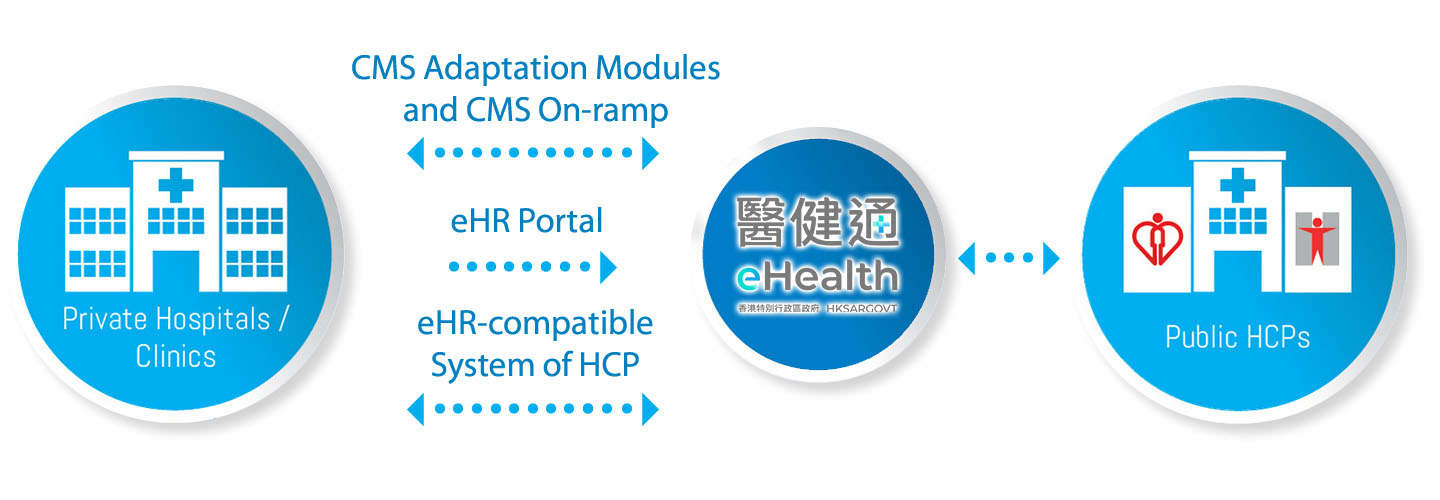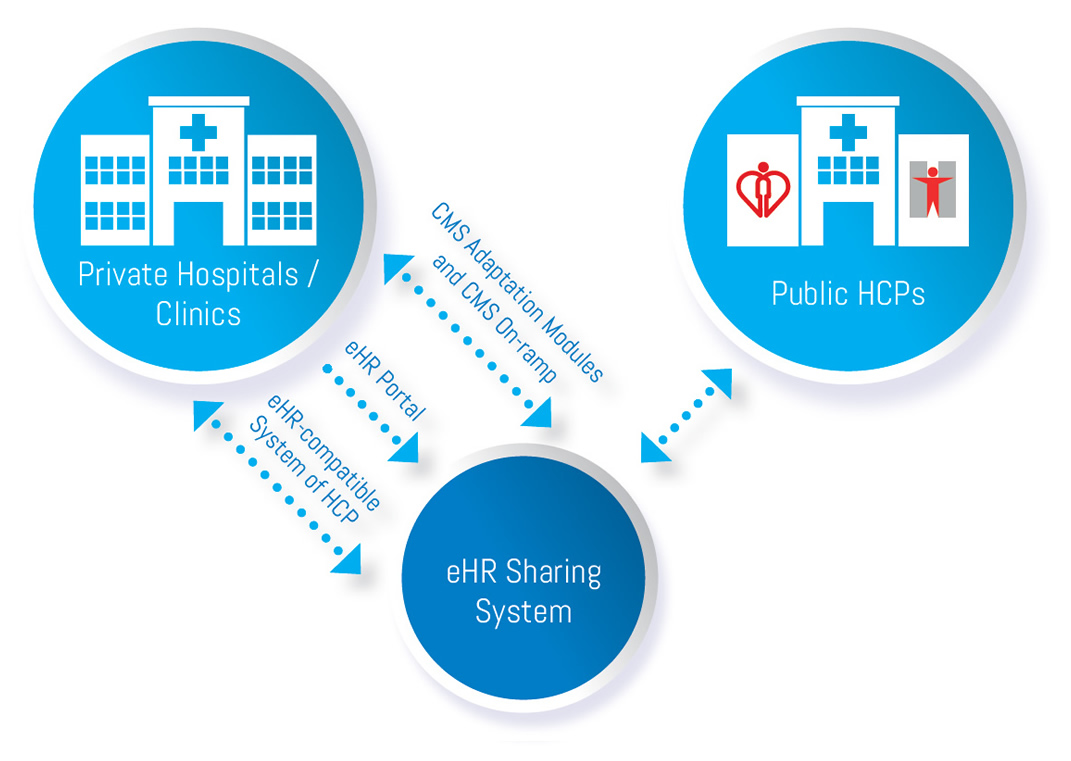
View electronic health record (eHR) only
Basically, an eHR-compatible computer system connected to the Internet is sufficient for accessing the Electronic Health System (eHealth) via the eHR portal.
View and share eHR
An eHR-enabled electronic medical record (eMR) system enables both viewing and sharing of eHRs (within the eHR sharable scope and subject to the agreement of healthcare provider (HCP)) to eHealth system –
- Government-developed eMR system / modules
- Free Clinical Management System (CMS) On-ramp and EC Connect are available to HCPs to support their operation and enable secure access to eHealth system.
- To facilitate the adoption and deployment of Hospital Authority (HA)'s CMS by private HCPs, especially private hospitals / clinics which would like to adopt HA's CMS components for their own use with minimal investment and maintenance. HA CMS adaptation and extension component will facilitate the deployment of eHR systems by IT vendors in private hospitals, private practitioners and HCPs which intend to adopt and use the HA systems.
- HCPs' eMR systems
HCPs can choose to use their own eMR systems to connect to eHealth system subject to compliance with the technical and security requirements as assessed by the eHR technical support team.
Connection modes
There are 3 different connection modes, namely, modes A, B and C, for connecting to eHealth. Participating HCPs may choose a connection mode that best suits their eMR system to connect to eHealth, e.g.
Private hospitals may choose mode A;
Private hospitals and some of the group practices / clinics with eMR systems may choose mode B;
Solo practices may choose mode C.
-
For connection mode A
ExpandCertified eMR system of the HCPs must be connected to eHealth via dedicated leased line or Virtual Private Network (VPN) connection through pre-registered gateway with digital certificate recognised by eHealth. eHealth would rely on the eMR system to perform well-proven and reliable user login control. Connection mode A allows a seamless integration between eHealth and the eMR system which eliminates the need for end-users to separately login.
-
For connection mode B
ExpandThe eMR system must be connected to eHealth system with fixed IP address or with registered security module called Encapsulated Linkage Security Application (ELSA) for connecting to eHealth system. The user authentication takes place at both the eMR system and eHealth system. Connection mode B allows integration between eHealth system and the eMR system to a lesser degree, since the end-users are required to login to eHealth system by a second factor credential.
-
For connection mode C
ExpandThe user workstations must be connected to eHealth system with fixed IP address, ELSA or eSC (eHealth Secure Connect). The user authentication process will only be performed at eHealth system. Mode C users are required to login using login name and password and user-selected second factor authentication means (such as SMS One-Time Password). During the initial phase, most solo practices may not have compatible eMR systems to connect to the sharing platform yet. They would access eHealth via mode C.
Self-service eHealth data sharing
The self-service eHealth data sharing is available for HCPs to implement electronic health data sharing between their own eMR systems and the eHealth system.
Frequently asked questions
-
Can I access eHealth system using a computer notebook connected to internet when I am providing home care to patients?Expand
Yes. You can access eHealth system through your notebook computer installed with software package for safe access to eHealth system. Due to security concerns, mobile devices, e.g. mobile phones or tablets, cannot access eHealth at present. You should observe relevant security guidelines in particular using eHealth system outside ordinary clinical settings e.g. using a public network.
-
What is ELSA?Expand
ELSA is a communication software module developed for the protection of the connection between your workstation and eHealth system. It also allows you to connect to both eHealth system with a single sign-on at a single site. It is provided freely to participating eHealth HCPs but you will be asked to read and agree to the ELSA licence terms before installation.
-
Is HCP required to carry out regular security audits on their eMR / ePR systems?Expand
Participating HCPs using different ways to connect to eHealth system will be subject to respective security compliance requirements below:
- HCP with mode A connection is required to submit Security Assessment Checklist yearly and Security Risk Assessment Audit (SRAA) report bi-yearly;
- HCP with mode B connection is required to submit Security Assessment Checklist yearly; and
- HCP with mode C connection is required to observe the Code of Practice (COP).
-
We have patients visited us and we may use our computer system every day. We are a bit concerned if eHR Office will come to our clinics and perform ad hoc or regular security audit checking which may affect our clinics' operation?Expand
- Performing audit is a general requirement for any computer system connecting with eHealth system for information sharing as set out in the COP and Conditions of Registration in eHealth.
- eHR Office shall carry out such audit on required basis and most probably in case for complaint and investigation.
- eHRC will try to minimise disturbance to clinical operation to HCPs as far as possible.
-
Does my computer need to be upgraded to view the radiology images in eHealth?Expand
No extra requirement is required for viewing radiology images, if your computer already meets the minimum hardware and software requirements for eHealth system. Take note that a stable internet connection is important for viewing images smoothly and a bandwidth of at least 50Mbps is recommended.
